
Digitalis is a genus of about 20 species of herbaceous perennial plants, shrubs, and biennials, commonly called foxgloves.

The Scrophulariaceae are a family of flowering plants, commonly known as the figwort family. The plants are annual and perennial herbs, as well as shrubs. Flowers have bilateral (zygomorphic) or rarely radial (actinomorphic) symmetry. The Scrophulariaceae have a cosmopolitan distribution, with the majority found in temperate areas, including tropical mountains. The family name is based on the name of the included genus Scrophularia L.
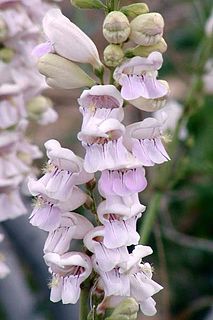
Penstemon, the beardtongues, is a large genus of roughly 250 species of flowering plants native mostly to the Nearctic, but with a few species also found in the North American portion of the Neotropics. It is the largest genus of flowering plants endemic to North America. Formerly placed in the family Scrophulariaceae by the Cronquist system, new genetic research has placed it in the vastly expanded family Plantaginaceae.

Antirrhinum is a genus of plants commonly known as dragon flowers, snapdragons and dog flower because of the flowers' fancied resemblance to the face of a dragon that opens and closes its mouth when laterally squeezed. They are native to rocky areas of Europe, the United States, Canada, and North Africa. It is widely used as an ornamental plant in borders and as a cut flower.

Plantaginaceae, the plantain family, is a family of flowering plants in the order Lamiales. In older classifications it used to be the only family of the order Plantaginales, but numerous phylogenetic studies, summarized by the Angiosperm Phylogeny Group, have demonstrated that this taxon should be included within Lamiales.
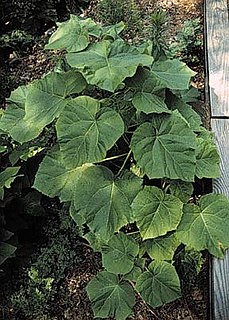
Paulowniaceae are a family of flowering plants within the Lamiales. They are a monophyletic and monogeneric family of trees with currently 7 confirmed species. They were formerly placed within Scrophulariaceae sensu lato, or as a segregate of the Bignoniaceae.

Phrymaceae, also known as the lopseed family, is a small family of flowering plants in the order Lamiales. It has a nearly cosmopolitan distribution, but is concentrated in two centers of diversity, one in Australia, the other in western North America. Members of this family occur in diverse habitats, including deserts, river banks and mountains.
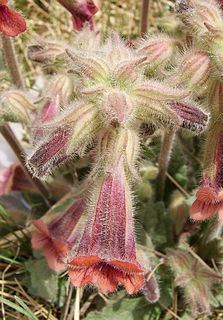
Rehmannia is a genus of seven species of flowering plants in the order Lamiales and family Orobanchaceae, endemic to China. It has been placed as the only member of the monotypic tribe Rehmannieae, but molecular phylogenetic studies suggest that it forms a clade with Triaenophora. Contrary to the immense majority of the taxa of Orobanchaceae, Rehmannia is not parasitic.
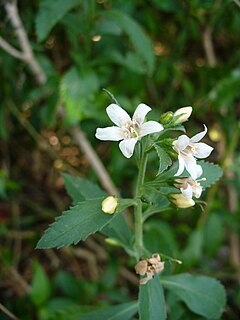
Capraria is a genus of flowering plants in the family Scrophulariaceae. It is sometimes placed in the families Gratiolaceae, Plantaginaceae, or Veronicaceae. The name is derived from the Latin word caprarius, meaning "pertaining to goats." This refers to goats being one of the few herbivores that will graze on the plants.

Nuttallanthus is a genus of four species of herbaceous annuals and perennials that was traditionally placed in the foxglove family Scrophulariaceae. Due to new genetic research, it has now been placed in the vastly expanded family Plantaginaceae. Three species of Nuttallanthus are native to North America and one to South America. Nuttallanthus was until the 1980s included in a wider circumscription of the genus Linaria, a genus now considered restricted to the Old World.

Veronicastrum virginicum, or Culver's root, is a species of flowering plant in the plantain family, native to the eastern United States and south-eastern Canada. Growing to 200 cm (79 in) tall by 45 cm (18 in) broad, it is an erect herbaceous perennial with slender racemes of white or occasionally pink or purple flowers in summer.

Linderniaceae is a family of flowering plants in the order Lamiales, which consists of about 25 genera and 265 species occurring worldwide. Vandellia micrantha is eaten in Laos, but tastes bitter. Best known are the wishbone flowers Torenia fournieri and Torenia thouarsii, which are used as bedding plants especially in the tropics. Micranthemum is sold as an aquarium plant when it is called 'baby tears'.

Chelone glabra, or white turtlehead, is a herbaceous species of plant native to North America. Its native range extends from Georgia to Newfoundland and Labrador and from Mississippi to Manitoba. Its common name comes from the appearance of its flower petals, which resemble the head of a tortoise. In fact, in Greek, chelone means "tortoise" and was the name of a nymph who refused to attend the wedding of Zeus and was turned into a turtle as punishment. Its natural habitat is wet areas, such as riparian forests and swamps.
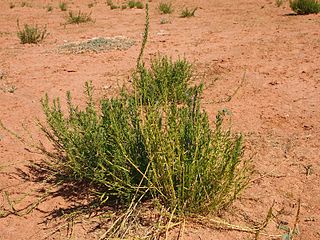
Stemodia is a genus of flowering plants in the family Plantaginaceae. The genus comprises approximately 40 species of annual and perennial herbs and shrubs which are distributed throughout temperate and tropical regions of Asia, Africa, Australia and the Americas. This genus is sometimes placed in the families Scrophulariaceae or Gratiolaceae. The generic name is derived from the Latin word stemodiacra, which means "stamens with two tips." Twintip is a common name for several species.
Philcoxia is a genus of seven rare plant species in the Plantaginaceae that are endemic to Brazil and resemble terrestrial species of the genus Utricularia. The genus, formally described in 2000, consists of the species P. bahiensis, P. goiasensis, P. minensis, P. tuberosa, P. rhizomatosa, P. maranhensis and P. courensis, each of the first three named for the Brazilian state to which it is endemic. The species are characterized by subterranean stems, peltate leaves at or below the soil surface, and five-lobed calyces. Their habitat has been reported as areas of white sand in the midst of cerrado vegetation at an elevation between 800 and 1450 m. Initial descriptions of the genus included suspicions that the plethora of stalked capitate glands on the upper surfaces of leaves was an indication that these species may be carnivorous. A study published in 2007 tested P. minensis for protease activity, a typical test for the carnivorous syndrome, and could detect none. Later studies detected other digestive enzymes such as phosphatases and qualitatively assessed prey digestion and nutrient uptake, suggesting that it is a true carnivorous plant. The genus epithet honors David Philcox, a botanist at Kew Gardens who worked extensively in tropical Scrophulariaceae.

Derwentia was a genus of flowering plants that is endemic to Australia. The genus was formerly included in the family Scrophulariaceae, but is currently included in Plantaginaceae, and is treated as a synonym of the genus Veronica.
Francis Whittier Pennell was an American botanist best known for his studies of the Scrophulariaceae. Employed by the New York Botanical Garden and then by the Academy of Natural Sciences of Philadelphia, he carried out botanical research in both North America and South America.
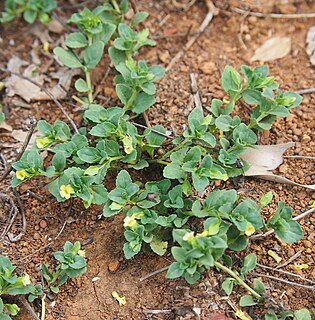
Mecardonia (axilflower) is a genus of herbaceous plants in the family Plantaginaceae. 31 species have been described, of which 12 are accepted. Its distribution is predominantly in South America, and South East United States, including Florida and Alabama but may be found as far north as Virginia. (see map) Five species are found in Argentina and three in the US.

The Antirrhineae are one of the 12 tribes of the family Plantaginaceae. It contains the toadflax relatives, such as snapdragons.

Veronica bellidioides is a flowering plant species in the genus Veronica of the family Plantaginaceae. It is native to Europe. This species was described by Carl von Linné.


















